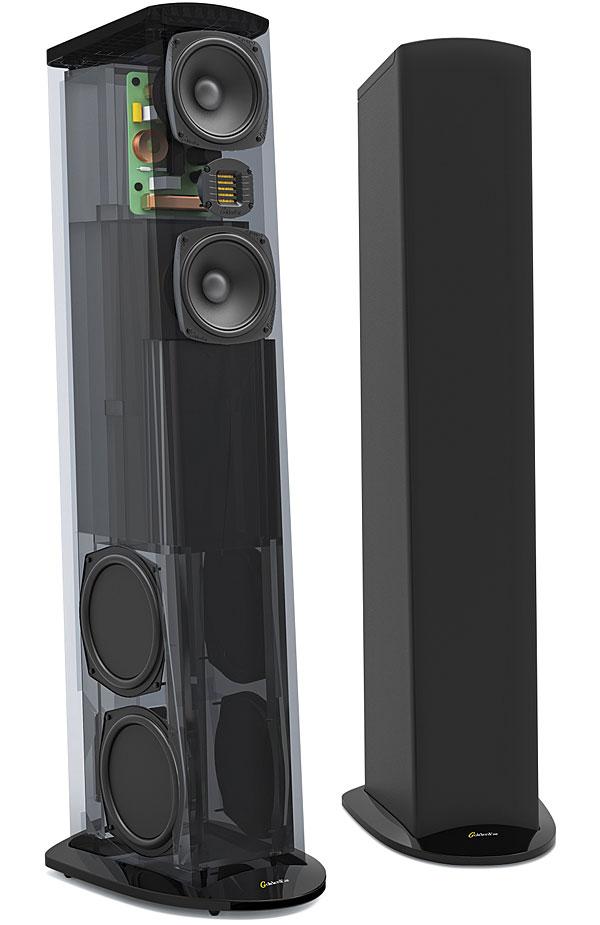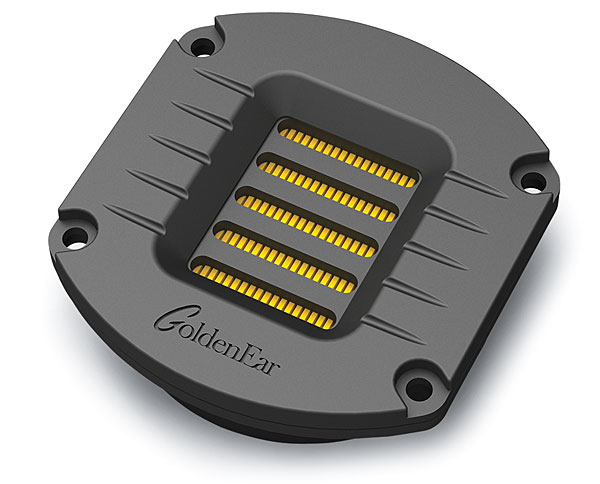Steve,
Any scheduled review set for the Triton ones? The ones have been the darling of the last year of every reviewer and perhaps the most talked about speaker of the last year, and would love your take.
If so, love to have you opinion on them vs Zu audio Drioids and also Magnepan 3.7i for the same price range, since you know those speakers very well as your reference speakers.
Thanks !!
GoldenEar Technology Triton Five Loudspeaker Review

AT A GLANCE
Plus
Sleek tower design
Huge soundstage!
HVFR planar magnetic folded ribbon tweeter
Minus
Black is the only finish
THE VERDICT
At less than $2,000 per pair, the Triton continues the GoldenEar value tradition with superb sonics at an attainable price.
I’ve known quite a few speaker designers and owners of high-end companies, but GoldenEar Technology’s CEO and co-founder Sandy Gross is the only one who’s an avid art collector. He paints a little, too, but mostly expresses his creative side through the sound of his loudspeakers. Gross has developed a keen ear as a decades-long veteran in the speaker business, co-founding Polk Audio and later Definitive Technology. In 2010, he launched GoldenEar Technology at the CEDIA show in Atlanta, Georgia.
Gross knows good sound when he hears it. (While you might assume that’s a given for anyone seeking a career in high-end audio, my experiences have often proven otherwise.) When you hang around with him, you get the feeling that his passions for great art and great sound feed off each other.
The Five Tritons
The Triton Five is but the latest installment in GoldenEar’s Triton series, and it breaks new ground, filling in another gap in what is now a five-speaker lineup. These include the One ($2,499 each) , Two ($1,499 each), and Three ($1,099 each), which include built-in powered subwoofers in progressively shorter towers. The Seven ($699 each), introduced in 2013, is a passive design, and the Five, also passive, respresents its big brother, with the intent of driving deeper bass and higher dynamics from a slightly taller cabinet. The Five certainly looks and feels more expensive than its moderate $999 each price point would lead you to expect. As with all the Tritons to date, it’s a lot of speaker for the money.
The Five’s front baffle features a D’Appolito array of two 6-inch woofers flanking GoldenEar’s High-Velocity Folded Ribbon (HVFR) planar magnetic tweeter. When you view the speaker from the side, it’s easy to see that its medium-density fiberboard cabinet is raked back a few degrees to better aim the three-driver array towards a seated listener. The cabinet’s non-parallel sides, and front and rear baffles, reduce internal standing waves. The Triton Five utilizes GoldenEar’s passive balanced crossover technology, which was initially developed for the Triton One. Sandy Gross told me the crossover uses polypropylene capacitors to enhance resolution capability. A single set of solid metal binding posts provides a secure grip on your speaker cables terminated with banana plugs, spades, or bare wires.
The Triton Five’s HVFR tweeter is identical to the ones used in most GoldenEar speakers, including the flagship Triton One. The only exceptions are the soundbars and in-wall speakers, which are outfitted with similar but smaller HVFRs. The Five also features four 8-inch, side-mounted passive radiators (two on each side), which are located close to the floor to optimize bass coupling. GoldenEar’s drivers are all said to be proprietary designs for which GoldenEar designs the tooling.

The Five, like its fellow Triton brethren, is covered in a black cloth sock that wraps around the front, sides, and rear. The top is fitted with a black gloss cap, and the bottom rests on a black gloss base.
Gross conceives all of the company’s speakers, but he’s not an audio engineer—so he relies on Bob Johnston, who leads a team of seven engineers to execute the plan. For the Triton Five, Gross started with the notion that this new speaker would be a bigger, scaled-up version of the Triton Seven and imagined it with two 6-inch woofers, the HVFR tweeter, and the slanted-back cabinet. He sketched out the cabinet’s rough dimensions and put the engineers to work.
As development progressed, they tested and measured prototypes in GoldenEar’s anechoic chamber, which is modelled after the one at Canada’s National Research Council in Ottawa, Ontario. GoldenEar is one of the lucky few speaker companies to have an anechoic chamber of its own, which says a lot about its commitment to quality. Gross’ ears had the final say on the Five’s sound; he’s the boss, after all.
Setting up a two-channel Triton Five system in my listening room was mostly a matter of determining how far the speakers would be placed from each other. I settled on 7 feet apart, slightly toed-in, and 8 feet from my couch. That’s where most speakers wind up in my room.
For multichannel home theater, you’d likely add GoldenEar’s SuperCenter X center-channel speaker ($600), SuperSat 3 satellites as surround speakers ($250 each), and ForceField 4 powered subwoofer ($700). And if you’re thinking about the possibility of adding ceiling speakers (for use with a receiver or processor featuring Dolby Atmos or DTS:X), GoldenEar offers the Invisa HTR 7000 in-ceiling speakers ($500 each). The age of object-oriented surround may be upon us, but two-channel home theater remains a viable alternative for folks with small rooms, or for anyone who wants to keep it simple, and that includes me.
I started my auditions with my reference two-channel gear—namely, a dCS Puccini CD player and, from Pass Laboratories, an XP-20 preamp and two XA100.5 100-watt monoblock amplifiers. The sound was most definitely up to snuff, but I quickly moved on to a less costly real-world setup, utilizing a Yamaha A-S801 stereo integrated amplifier and an Oppo BDP-105 universal player.
Listening to a Pair of Fives
Whenever I review a set of tower speakers, there comes a time when I feel compelled to put the pedal to the metal—and for the Triton Fives, I grabbed a fistful of the newly remastered Led Zeppelin CDs. These albums sound more transparent than ever before, that’s for sure. Robert Plant’s lung-popping vocals reached out and knocked me over. When I turned up “Moby Dick,” the full measure of John Bonham’s primeval drum solo amply demonstrated the Fives’ athletic abilities. The louder I played them, the better I felt! Indeed, I found these speakers seem to like moderate to high volume; they were less satisfying at hushed, late-night levels.
Rickie Lee Jones’ Pop Pop CD is one of my go-to choices when I want unadulterated vocals. Through the Triton Fives, Ms. Jones’ pipes sounded as natural as I’ve ever heard them, and string bassist John Leftwich propelled “Dat Dere” with his ever-so-nimble dexterity. Pop Pop forgoes added reverb or processing; we get just Jones and her merry band, and that’s plenty. Purely acoustic music from violinist Joshua Bell and bassist Edgar Meyer’s Short Trip Home CD rang true as well, thanks to the Triton Fives’ tonal realism.
I love how the SACD of Miles Davis’ In a Silent Way delineates each instrument’s dynamic envelope, including Chick Corea and Herbie Hancock’s swirling electric pianos, Tony Williams’ cymbals, John McLaughlin’s guitar, and of course Davis’ trumpet, which is always floating above the fray. The mix is dense with energy and texture, and the Fives dug deep into the sounds of the session.
I settled in for some home theater trials with Richard Linklater’s Boyhood and immediately forgot all about the Triton Fives. Dialogue was firmly planted in the “phantom” center channel, and voices sounded natural. The film is devoid of special effects, so the Fives just went about their business without calling attention to themselves. I love the scene late in the film where Ethan Hawke’s character sings and plays acoustic guitar with his children and extended family. The sound was so intimate, I felt like I was in the room with them all.
Terry Gilliam’s whacked-out The Zero Theorem takes a very different turn. Qohen Leth (Christoph Waltz) is a depressed “entity cruncher” who spends his days trying to solve the titular theorem while working inside what looks like a giant steampunk computer. The soundtrack is big on texture, including low bass thumps and throbs, not to mention a blizzard of buzzes, bleeps, clicks, and whooshes. The Triton Fives served up the reverberant acoustics of Qohen’s deconsecrated church/home, replete with the sound of a white pigeon fluttering about.
When I pumped up the Rolling Stones’ recently released From the Vault: Hampton Coliseum (Live in 1981) on Blu-ray, the first thing I noticed was Bill Wyman’s bass playing. The band has never been the same since he left in 1992. Man, oh man, Wyman and drummer Charlie Watts’ rhythms were so solid, and when the band stretches out and jams on “Neighbours,” the crowd’s cheers were set deep in the soundstage. In 1981, the Stones were still “the greatest rock ’n’ roll band in the world.” The Triton Fives left no doubt about that.
My reference Zu Audio Druid V speakers ($5,400/pair) are in some ways more exciting performers—they have superior dynamic slam and more top-end sparkle—but the Triton Fives, at less than half their cost, make more bass, and the HVFR tweeter’s treble is sweeter and resolves fine detail better. That makes for a very “livable” speaker. Once again, Gross and GoldenEar have delivered a fine work of audio art at a highly affordable price.
- Log in or register to post comments



Thx, I know abut the review.
Wanted Steve's take especially compared to Maggie's and Zu audio, his reference speakers for the same price point.

"I found these speakers seem to like moderate to high volume; they were less satisfying at hushed, late-night levels" - This is a common drawback for most sealed-box speakers. While they are more efficient at power handling than ported speakers, the pressure built-up in the box prevents the speaker drivers from moving freely at low volume listening.






























































